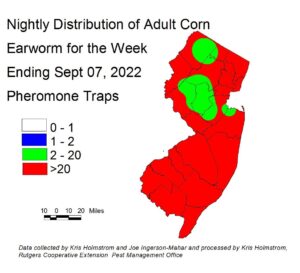Sweet Corn
European corn borer (ECB) moth catches have declined, and are at very low levels throughout the state. At this time, no feeding has been detected.
The highest nightly trap catches of ECB for the week ending 09/07/22 are as follows:
| Allentown 2 | Lawrenceville 1 |
| New Egypt 2 | Pennington 1 |
| Crosswicks 1 | |
| Georgetown 1 |
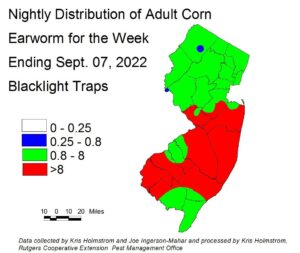 Corn earworm (CEW) moth captures from both blacklight traps and pheromone traps have stabilized at high – to – very high levels . Pheromone traps from Burlington County south through Cape May continue to register very high numbers, with northern Warren County also having a heavy catch. Both trap types are in general agreement as to spray schedules. We are in the high activity portion of the summer. CEW populations can increase or decline with changes in night temperatures. Growers should be on alert for large CEW migrations should NJ experience strong low pressure fronts approaching from the west. Check this publication weekly for CEW status. The number of pheromone traps deployed is much lower, resulting in much broader color bands on the map. It is also important to understand that pheromone traps are more sensitive than blacklight traps, and thresholds are adjusted to account for the higher catches typical of this trap type. Silking corn is at risk of CEW infestation at this time. On the blacklight map (left), red areas represent a 2-3 day spray schedule. Green areas represent a 3-day silk spray schedule. On the pheromone map (below right), red represents a 3-day spray schedule, green represents a 4-day schedule. Be sure to access information from this publication in the upcoming weeks to determine how frequently you should treat silking sweet corn to protect it from CEW infestation.
Corn earworm (CEW) moth captures from both blacklight traps and pheromone traps have stabilized at high – to – very high levels . Pheromone traps from Burlington County south through Cape May continue to register very high numbers, with northern Warren County also having a heavy catch. Both trap types are in general agreement as to spray schedules. We are in the high activity portion of the summer. CEW populations can increase or decline with changes in night temperatures. Growers should be on alert for large CEW migrations should NJ experience strong low pressure fronts approaching from the west. Check this publication weekly for CEW status. The number of pheromone traps deployed is much lower, resulting in much broader color bands on the map. It is also important to understand that pheromone traps are more sensitive than blacklight traps, and thresholds are adjusted to account for the higher catches typical of this trap type. Silking corn is at risk of CEW infestation at this time. On the blacklight map (left), red areas represent a 2-3 day spray schedule. Green areas represent a 3-day silk spray schedule. On the pheromone map (below right), red represents a 3-day spray schedule, green represents a 4-day schedule. Be sure to access information from this publication in the upcoming weeks to determine how frequently you should treat silking sweet corn to protect it from CEW infestation.
The highest nightly blacklight trap catches of CEW for the week ending 09/07/22 are as follows:
| Crosswicks 36 | Allentown 14 | Tabernacle 10 |
| Georgetown 30 | New Egypt 14 | Bellemeade 9 |
| Farmingdale 17 | Old Bridge 13 | Denville 8 |
| Pennington 15 | Woodstown 12 | Morristown 8 |
The highest nightly pheromone trap catches of CEW for the week ending 09/07/22 are as follows:
| Jones Island 261 | Allamuchy 101 | Farmingdale 35 |
| Tabernacle 109 | Eldora 92 | Snyder Farm (Hunterdon) 25 |
| Georgetown 108 | Springdale 66 | Matawan 16 |
| East Vineland 103 | Green Creek 65 | Califon 15 |
Silking Spray Schedules*:
South – 3 days
Central – 3 days
North – 3 days
*These recommendations are based on regional catches. Adhere to tighter spray schedules if indicated by local trap catches. Synthetic pyrethroids alone should NOT be used for corn earworm (CEW) protection on silking corn, or for fall armyworm (FAW) management at any stage. Control with these materials is very inconsistent. Utilize materials in IRAC groups 5 and 28, or combination products that include IRAC group 28 for best control. See the Sweet Corn section of the 2020-21 Commercial Vegetable Production Guide for selections.
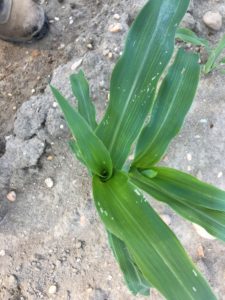
 Fall armyworm (FAW) continues to infest whorl and seedling stage corn at low to moderate levels throughout the state. Bayshore and Atlantic coastal areas are experiencing the highest infestation rates. Injury from newly hatched larvae shows up as “window panes”, or areas where leaf issue has been eaten down the the lower epidermis (see photo at far left). This injury leads down into the whorl. As larvae gain size, they begin to consume leaf tissue in its’ entirety, creating ragged holes and lots of droppings (see photo at near left). FAW can be tough to manage because it is resistant to synthetic pyrethroid insecticides (IRAC 3A) and because larvae are often covered by their own droppings, making contact with the insecticide more difficult. Treat when 12% or more plants exhibit FAW injury alone, or in combination with ECB injury. As a rule, insecticides that are most effective on CEW will also adequately control FAW.
Fall armyworm (FAW) continues to infest whorl and seedling stage corn at low to moderate levels throughout the state. Bayshore and Atlantic coastal areas are experiencing the highest infestation rates. Injury from newly hatched larvae shows up as “window panes”, or areas where leaf issue has been eaten down the the lower epidermis (see photo at far left). This injury leads down into the whorl. As larvae gain size, they begin to consume leaf tissue in its’ entirety, creating ragged holes and lots of droppings (see photo at near left). FAW can be tough to manage because it is resistant to synthetic pyrethroid insecticides (IRAC 3A) and because larvae are often covered by their own droppings, making contact with the insecticide more difficult. Treat when 12% or more plants exhibit FAW injury alone, or in combination with ECB injury. As a rule, insecticides that are most effective on CEW will also adequately control FAW.
Two-spotted spider mites (TSSM) continue to infest sweet corn plantings as they approach the silk stage, although recent heavy rains should ease this situation somewhat. Insecticide applications for CEW control often intensify these infestations. Check plantings prior to the onset of silks. Mite populations in corn will result in lower leaves first appearing “dusty”, and ultimately turning yellow. This condition progresses up the plant as mite populations increase. If mites are detected in any plantings, the addition of the miticide Oberon (5-day PHI) to the normal silk spray schedule can help minimize injury. Zeal is also labeled in corn but must be used early in the silk schedule as it carries a 21 day PHI.
Tomatoes
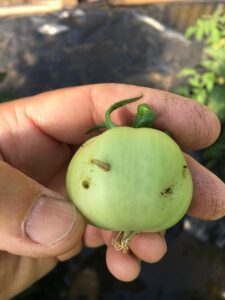 Consideration should be given to protecting tomato plantings from CEW in tomatoes (called the fruitworm, when found in tomatoes). Larger populations locally, (>20 CEW/night) in local pheromone traps are a signal that growers should be inspecting tomato plantings at least weekly for signs of fruit injury. Typically, the female CEW moth lays eggs in blossom clusters near the outer canopy of the plant. Larvae hatching from these eggs begin feeding on the nearest fruit (photo at left), making damage very visible while walking the planting. At the first sign of this injury, growers should initiate control, with insecticides in the IRAC 5 and 28 classes most effective, with short PHIs. There are a number of effective insecticides listed in the Tomato Section from the 2022-23 Guide.
Consideration should be given to protecting tomato plantings from CEW in tomatoes (called the fruitworm, when found in tomatoes). Larger populations locally, (>20 CEW/night) in local pheromone traps are a signal that growers should be inspecting tomato plantings at least weekly for signs of fruit injury. Typically, the female CEW moth lays eggs in blossom clusters near the outer canopy of the plant. Larvae hatching from these eggs begin feeding on the nearest fruit (photo at left), making damage very visible while walking the planting. At the first sign of this injury, growers should initiate control, with insecticides in the IRAC 5 and 28 classes most effective, with short PHIs. There are a number of effective insecticides listed in the Tomato Section from the 2022-23 Guide.
Peppers
So far, only one farm (East Vineland area) seems to have a significant pepper weevil population. The other East Vineland location has a light infestation. The concern over weevils will begin to diminish in September with generally cooler temperatures and some pepper fields being tilled up.
The best control rotations for pepper weevil include Vydate, a neonicotinoid (Actara, Admire, Assail, others), a diamide (Exirel, Harvanta), and possibly Torac. University of Georgia researchers have found that all populations of pepper weevil that they have tested are resistant to pyrethroids. Since we don’t know where the weevils come from that we find here in New Jersey, farmers probably shouldn’t rely on pyrethroids being effective. Refer to the Rutgers Fact Sheet, FS1330: Monitoring and Management of Pepper Weevil in New Jersey (Rutgers NJAES) for more details on monitoring pepper weevil populations.
Beet armyworm adults (BAW) continue to be captured over the past week. Nightly counts include:
| Jones Island 13 | Folsom 1 |
| East Vineland 1 | Woodstown 1 |
Growers in Gloucester, Salem and Cumberland counties should monitor pepper fields weekly for signs of feeding. BAW larvae (photo at left) feed in the developing foliage in terminal growth of plants. Initially, leaves are skeletonized, but as larvae grow, they will move onto fruit and damage these as well. 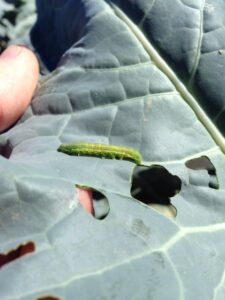 As with other armyworms, BAW is difficult to control with pyrethroid insecticides. Effective materials include spinosyns (IRAC 5) and diamides (IRAC 28).
As with other armyworms, BAW is difficult to control with pyrethroid insecticides. Effective materials include spinosyns (IRAC 5) and diamides (IRAC 28).
Pumpkins and Winter Squash
Cucurbit downy mildew (CDM) is active on cucumbers in all parts of the state, and has recently been discovered on summer squash in southern NJ (See Dr. Wyenandt’s alert of 9/5). As of 9/7, no infections have been detected on other cucurbits in NJ, including pumpkins, butternut squash, acorn squash and watermelons. As of Tuesday 9/06, the CDM forecast was for high risk of new infection in all of NJ. Rains of 9/6 and continued cloudy weather on 9/7 are conducive to local spread. For regional information on this important disease, see the Cucurbit Downy Mildew Forecast webpage: http://cdm.ipmpipe.org/. It is advisable that all growers treat preventively for CDM on all vine crops until clear, dry weather resumes and infections either become evident or are determined not to have occurred.
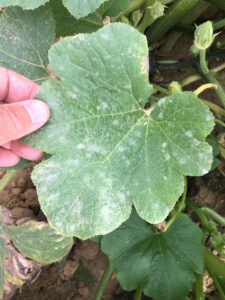 Powdery mildew (PM) infections are present in all scouted pumpkin and winter squash fields, and protectant spray programs for this fungal disease are ongoing. Growers should include protectant and systemic fungicides for powdery mildew management. For a review of PM control, see Dr. Andy Wyenandt’s article on PM control from earlier this season.
Powdery mildew (PM) infections are present in all scouted pumpkin and winter squash fields, and protectant spray programs for this fungal disease are ongoing. Growers should include protectant and systemic fungicides for powdery mildew management. For a review of PM control, see Dr. Andy Wyenandt’s article on PM control from earlier this season.
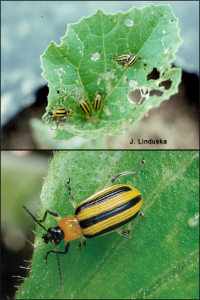 As fruit develop and mature in fields, growers should check at least weekly for the presence of striped cucumber beetles (photo at right). This pest, which is important early in the life of the plants, again becomes economically significant with maturing fruit, as it can scar the rinds of pumpkins and other squashes. If cucumber beetles are found at more than 2 sites in a 10 site sample, and any fruit injury is detected, an insecticide application to prevent further injury may be warranted. For useful materials, see the Pumpkin and Winter Squash section of the 2022-23 Commercial Guide. As of this week, populations of melon aphids have begun to appear in pumpkin and winter squash fields (see photo below at left). This pest has the ability to increase to extremely high population levels in fields. When this happens, their sticky droppings are deposited on fruit below the canopy. Sooty
As fruit develop and mature in fields, growers should check at least weekly for the presence of striped cucumber beetles (photo at right). This pest, which is important early in the life of the plants, again becomes economically significant with maturing fruit, as it can scar the rinds of pumpkins and other squashes. If cucumber beetles are found at more than 2 sites in a 10 site sample, and any fruit injury is detected, an insecticide application to prevent further injury may be warranted. For useful materials, see the Pumpkin and Winter Squash section of the 2022-23 Commercial Guide. As of this week, populations of melon aphids have begun to appear in pumpkin and winter squash fields (see photo below at left). This pest has the ability to increase to extremely high population levels in fields. When this happens, their sticky droppings are deposited on fruit below the canopy. Sooty 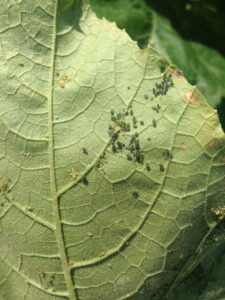 mold fungus grows on this sticky coating, disfiguring fruit. Additionally, hornets are attracted to the aphid droppings; creating a potential issue in U-pick situations. Check fields weekly for the presence of melon aphid colonies developing on the undersides of leaves. If aphids are found in more than one sample site/10 sites, consider an insecticide application to limit population spread. There are a number of effective materials listed in the Pumpkin and Winter Squash section of the 2022-23 Commercial Guide. Avoid pyrethroid insecticides for aphids or other insect pests, as these can cause aphids to increase.
mold fungus grows on this sticky coating, disfiguring fruit. Additionally, hornets are attracted to the aphid droppings; creating a potential issue in U-pick situations. Check fields weekly for the presence of melon aphid colonies developing on the undersides of leaves. If aphids are found in more than one sample site/10 sites, consider an insecticide application to limit population spread. There are a number of effective materials listed in the Pumpkin and Winter Squash section of the 2022-23 Commercial Guide. Avoid pyrethroid insecticides for aphids or other insect pests, as these can cause aphids to increase.
Cole Crops
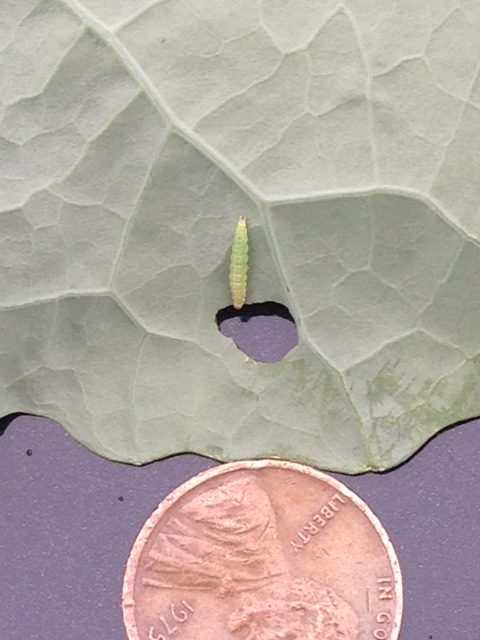 Host availability and elevated temperatures have made diamondback moth larvae ((DBM) see photo at right) the dominant caterpillar pest in many cole crop plantings. This pest can multiply quickly, with a generation completed in under 2 weeks with high temperatures. Furthermore, it is apparent that this pest is not responding to chlorantraniliprole (Coragen) in many parts of the state. Effective materials continue to be IRAC 5 materials (spinosyns), other IRAC 28 products like Exirel, and the IRAC 6 material, ememectin benzoate (Proclaim). Be sure to check the Cole Crops Section of the 2022-23 Commercial Guide for specifics, as PHI’s and crop labels vary. It is important to return to treated fields within 2-3 days to assess the efficacy of the insecticide applications. Effective materials should eliminate DBM larvae within 48 hours.
Host availability and elevated temperatures have made diamondback moth larvae ((DBM) see photo at right) the dominant caterpillar pest in many cole crop plantings. This pest can multiply quickly, with a generation completed in under 2 weeks with high temperatures. Furthermore, it is apparent that this pest is not responding to chlorantraniliprole (Coragen) in many parts of the state. Effective materials continue to be IRAC 5 materials (spinosyns), other IRAC 28 products like Exirel, and the IRAC 6 material, ememectin benzoate (Proclaim). Be sure to check the Cole Crops Section of the 2022-23 Commercial Guide for specifics, as PHI’s and crop labels vary. It is important to return to treated fields within 2-3 days to assess the efficacy of the insecticide applications. Effective materials should eliminate DBM larvae within 48 hours.
